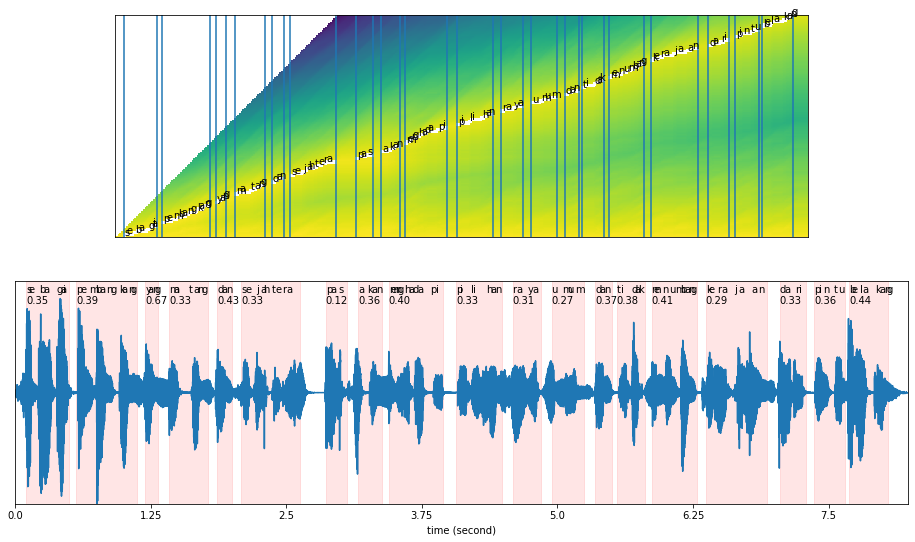Force Alignment using CTC
Contents
Force Alignment using CTC#
Forced alignment is a technique to take an orthographic transcription of an audio file and generate a time-aligned version. In this example, I am going to use Malay CTC model.
This tutorial is available as an IPython notebook at malaya-speech/example/force-alignment-ctc.
This module is not language independent, so it not save to use on different languages. Pretrained models trained on hyperlocal languages.
[1]:
import os
os.environ['CUDA_VISIBLE_DEVICES'] = ''
[2]:
import malaya_speech
import numpy as np
from malaya_speech import Pipeline
import IPython.display as ipd
import matplotlib.pyplot as plt
from malaya_speech.utils.aligner import plot_alignments
`pyaudio` is not available, `malaya_speech.streaming.pyaudio` is not able to use.
List available CTC models#
[3]:
malaya_speech.force_alignment.ctc.available_transformer()
[3]:
| Size (MB) | Quantized Size (MB) | malay-malaya | Language | |
|---|---|---|---|---|
| hubert-conformer-tiny | 36.6 | 10.3 | {'WER': 0.238714008166, 'CER': 0.060899814, 'W... | [malay] |
| hubert-conformer | 115 | 31.1 | {'WER': 0.2387140081, 'CER': 0.06089981404, 'W... | [malay] |
| hubert-conformer-large | 392 | 100 | {'WER': 0.2203140421, 'CER': 0.0549270416, 'WE... | [malay] |
Load CTC Aligner model#
def transformer(
model: str = 'hubert-conformer', quantized: bool = False, **kwargs
):
"""
Load Encoder-CTC ASR model.
Parameters
----------
model : str, optional (default='hubert-conformer')
Check available models at `malaya_speech.force_alignment.ctc.available_transformer()`.
quantized : bool, optional (default=False)
if True, will load 8-bit quantized model.
Quantized model not necessary faster, totally depends on the machine.
Returns
-------
result : malaya_speech.model.wav2vec.Wav2Vec2_Aligner class
"""
[4]:
model = malaya_speech.force_alignment.ctc.transformer(model = 'hubert-conformer')
2023-03-06 15:37:35.282571: I tensorflow/core/platform/cpu_feature_guard.cc:142] This TensorFlow binary is optimized with oneAPI Deep Neural Network Library (oneDNN) to use the following CPU instructions in performance-critical operations: AVX2 FMA
To enable them in other operations, rebuild TensorFlow with the appropriate compiler flags.
2023-03-06 15:37:35.305928: E tensorflow/stream_executor/cuda/cuda_driver.cc:271] failed call to cuInit: CUDA_ERROR_NO_DEVICE: no CUDA-capable device is detected
2023-03-06 15:37:35.305961: I tensorflow/stream_executor/cuda/cuda_diagnostics.cc:169] retrieving CUDA diagnostic information for host: husein-MS-7D31
2023-03-06 15:37:35.305965: I tensorflow/stream_executor/cuda/cuda_diagnostics.cc:176] hostname: husein-MS-7D31
2023-03-06 15:37:35.306047: I tensorflow/stream_executor/cuda/cuda_diagnostics.cc:200] libcuda reported version is: 470.161.3
2023-03-06 15:37:35.306062: I tensorflow/stream_executor/cuda/cuda_diagnostics.cc:204] kernel reported version is: 470.161.3
2023-03-06 15:37:35.306064: I tensorflow/stream_executor/cuda/cuda_diagnostics.cc:310] kernel version seems to match DSO: 470.161.3
Load sample#
Malay samples#
[5]:
malay1, sr = malaya_speech.load('speech/example-speaker/shafiqah-idayu.wav')
malay2, sr = malaya_speech.load('speech/example-speaker/haqkiem.wav')
[6]:
texts = ['nama saya shafiqah idayu',
'sebagai pembangkang yang matang dan sejahtera pas akan menghadapi pilihan raya umum dan tidak menumbang kerajaan dari pintu belakang']
[7]:
ipd.Audio(malay2, rate = sr)
[7]:
Predict#
def predict(self, input, transcription: str, sample_rate: int = 16000):
"""
Transcribe input, will return a string.
Parameters
----------
input: np.array
np.array or malaya_speech.model.frame.Frame.
transcription: str
transcription of input audio.
sample_rate: int, optional (default=16000)
sample rate for `input`.
Returns
-------
result: Dict[chars_alignment, words_alignment, alignment]
"""
Predict Malay#
Our original text is: ‘sebagai pembangkang yang matang dan sejahtera pas akan menghadapi pilihan raya umum dan tidak menumbang kerajaan dari pintu belakang’
[8]:
results = model.predict(malay2, texts[1])
2023-03-06 15:37:45.494170: W tensorflow/core/framework/cpu_allocator_impl.cc:80] Allocation of 53942272 exceeds 10% of free system memory.
2023-03-06 15:37:45.523388: W tensorflow/core/framework/cpu_allocator_impl.cc:80] Allocation of 53942272 exceeds 10% of free system memory.
2023-03-06 15:37:45.533111: W tensorflow/core/framework/cpu_allocator_impl.cc:80] Allocation of 53942272 exceeds 10% of free system memory.
2023-03-06 15:37:45.537104: W tensorflow/core/framework/cpu_allocator_impl.cc:80] Allocation of 53942272 exceeds 10% of free system memory.
2023-03-06 15:37:45.560074: W tensorflow/core/framework/cpu_allocator_impl.cc:80] Allocation of 53942272 exceeds 10% of free system memory.
[9]:
results.keys()
[9]:
dict_keys(['chars_alignment', 'words_alignment', 'alignment'])
[10]:
results['words_alignment']
[10]:
[{'text': 'sebagai',
'start': 0.10013914233576643,
'end': 0.5006957116788322,
'start_t': 5,
'end_t': 25,
'score': 0.3489727854749466},
{'text': 'pembangkang',
'start': 0.560779197080292,
'end': 1.121558394160584,
'start_t': 28,
'end_t': 56,
'score': 0.3905156936487866},
{'text': 'yang',
'start': 1.2016697080291971,
'end': 1.321836678832117,
'start_t': 60,
'end_t': 66,
'score': 0.6657784879221825},
{'text': 'matang',
'start': 1.4219758211678832,
'end': 1.7824767335766425,
'start_t': 71,
'end_t': 89,
'score': 0.3326612651595179},
{'text': 'dan',
'start': 1.8625880474452556,
'end': 2.002782846715329,
'start_t': 93,
'end_t': 100,
'score': 0.42831442185974067},
{'text': 'sejahtera',
'start': 2.0828941605839417,
'end': 2.6236455291970806,
'start_t': 104,
'end_t': 131,
'score': 0.3320172826619074},
{'text': 'pas',
'start': 2.86397947080292,
'end': 3.064257755474453,
'start_t': 143,
'end_t': 153,
'score': 0.11881570829171921},
{'text': 'akan',
'start': 3.164396897810219,
'end': 3.3847030109489054,
'start_t': 158,
'end_t': 169,
'score': 0.3623451807407769},
{'text': 'menghadapi',
'start': 3.444786496350365,
'end': 3.945482208029197,
'start_t': 172,
'end_t': 197,
'score': 0.3988869787777544},
{'text': 'pilihan',
'start': 4.065649178832117,
'end': 4.486233576642336,
'start_t': 203,
'end_t': 224,
'score': 0.33269549836911727},
{'text': 'raya',
'start': 4.586372718978103,
'end': 4.846734489051095,
'start_t': 229,
'end_t': 242,
'score': 0.30750036704822425},
{'text': 'umum',
'start': 4.946873631386862,
'end': 5.247291058394161,
'start_t': 247,
'end_t': 262,
'score': 0.26633543572989365},
{'text': 'dan',
'start': 5.347430200729927,
'end': 5.507652828467154,
'start_t': 267,
'end_t': 275,
'score': 0.3746163249118229},
{'text': 'tidak',
'start': 5.54770848540146,
'end': 5.808070255474453,
'start_t': 277,
'end_t': 290,
'score': 0.3845034150083503},
{'text': 'menumbang',
'start': 5.868153740875913,
'end': 6.288738138686131,
'start_t': 293,
'end_t': 314,
'score': 0.4133131646062338},
{'text': 'kerajaan',
'start': 6.368849452554745,
'end': 6.9296286496350366,
'start_t': 318,
'end_t': 346,
'score': 0.2856007218372845},
{'text': 'dari',
'start': 7.049795620437957,
'end': 7.290129562043796,
'start_t': 352,
'end_t': 364,
'score': 0.3331856578826829},
{'text': 'pintu',
'start': 7.370240875912409,
'end': 7.650630474452555,
'start_t': 368,
'end_t': 382,
'score': 0.3570024328726298},
{'text': 'belakang',
'start': 7.690686131386862,
'end': 8.05118704379562,
'start_t': 384,
'end_t': 402,
'score': 0.4434706668115288}]
Plot alignment#
def plot_alignments(
alignment,
subs_alignment,
words_alignment,
waveform,
separator: str = ' ',
sample_rate: int = 16000,
figsize: tuple = (16, 9),
plot_score_char: bool = False,
plot_score_word: bool = True,
):
"""
plot alignment.
Parameters
----------
alignment: np.array
usually `alignment` output.
subs_alignment: list
usually `chars_alignment` or `subwords_alignment` output.
words_alignment: list
usually `words_alignment` output.
waveform: np.array
input audio.
separator: str, optional (default=' ')
separator between words, only useful if `subs_alignment` is character based.
sample_rate: int, optional (default=16000)
figsize: tuple, optional (default=(16, 9))
figure size for matplotlib `figsize`.
plot_score_char: bool, optional (default=False)
plot score on top of character plots.
plot_score_word: bool, optional (default=True)
plot score on top of word plots.
"""
[11]:
plot_alignments(alignment = results['alignment'],
subs_alignment = results['chars_alignment'],
words_alignment = results['words_alignment'],
waveform = malay2,
separator = ' ',
sample_rate = 16000,
figsize = (16, 9))

What if we give wrong transcription?#
[15]:
results = model.predict(malay2, 'husein sangat comel')
[17]:
plot_alignments(alignment = results['alignment'],
subs_alignment = results['chars_alignment'],
words_alignment = results['words_alignment'],
waveform = malay2,
separator = ' ',
sample_rate = 16000,
figsize = (16, 9))

The text output not able to align, and returned scores very low.
